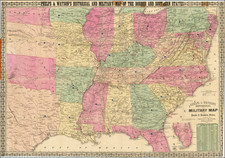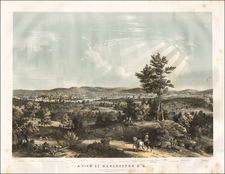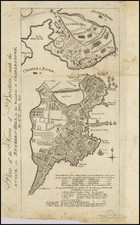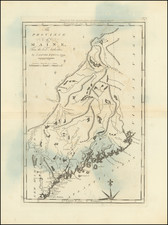Fine example of Benjamin Franklin's Chart of the Gulf Stream and accompanying letter, which appeared in the the Transactions of the American Philosophical Society in 1786.
Franklin's map is one of the earliest maps to provide a detailed depiction of the Gulf Stream, pre-dated only by several virtually unobtainable maps prepared at Franklin's direction in London and Paris. The accompanying remarks provide Franklin's own comments on the location of the Gulf Stream, based upon his observations and the observations of his nephew, Timothy Folger, who assisted Franklin in compiling the information necessary to make this initial charting of the Gulf Stream.
The Gulf Stream is one of the most important natural phenomenon affecting navigators in the Atlantic Ocean. First named by Benjamin Franklin, the Gulf Stream is a high speed river within the ocean, flowing from the Gulf of Mexico, around the southern tip of Florida and along the East Coast of North America to Cape Hatteras, before turning eastward across the Atlantic Ocean, where it continues to Iceland, the British Isles and Norway.
The strength of the flow of the current was first observed by Ponce de Leon on his return trip from St. Augustine, Florida in 1513. His pilot, Anton de Alaminos, utilized his observations to chart a course for Cortes' treasure ships returning from Mexico which significantly shortened the transatlantic voyage home. While the Spanish sailed the Gulf Stream waters for centuries, they managed to keep the existence of the Gulf Stream a secret from other nations.
The western portion of the "Northeast Current," as it was known before Franklin named it the "Gulf Stream" in 1762, was first described by Walter Haxton, a captain engaged in shipping tobacco from his Maryland farms to London merchants. In 1735 ,Haxton drew the first large-scale mariner's chart of Chesapeake Bay, giving detailed soundings and sailing directions. He included, as an addendum to the chart, latitude and longitude points locating the "Northeast Current" along with estimates of the current's velocity. While Haxton advocated use of the current for future crossings, he was largely ignored.
Benjamin Franklin began his study of the Gulf Stream in the late 1760s, while serving as the postmaster of the British Colonies in North America. As noted by Franklin in the Transactions:
About the year 1769 or 70, there was an application made by the board of customs at Boston, to the lords of the treasury in London, complaining that the packets between Falmouth and New-York, were generally a fortnight longer in their passages, than merchant ships from London to Rhode-Island…. Being then concerned in the management of the American post-office, I happened to be consulted on the occasion…. There happened then to be in London, a Nantucket sea-captain of my acquaintance [Franklin's cousin Timothy Folger]…. He told he believed the fact might be true; but the difference was owing to this, that the Rhode-Island captains were acquainted with the gulf stream, which those of the English packets were not.(Transactions, vol. II, p. 314)
Franklin had Folger draw the current on a chart, after which he
had Folger's chart printed and distributed to British packet captains in 1769 or 1770, but they tended to ignore it, perhaps because they couldn't admit that colonial fishermen knew more about the ocean than did highly trained and experienced British mariners. When the American Revolution commenced, Franklin ceased distribution of the chart to prevent the British fleet from having the advantage of such valuable information.
In March of 1775 Franklin left London and sailed for home. The next year he was sent as envoy to Paris to negotiate a treaty with the French government. During those two transatlantic crossings Franklin tested the temperature of the Gulf Stream and learned that it was warmer than the surrounding waters. The discovery renewed his interest in the Timothy Folger chart, and he had it copied and printed by Le Rouge following his arrival in Paris. He intended to provide copies to all French ship captains carrying arms and supplies to the American colonies." (Captain John Lacoutere, USN, ret., "The Gulf Stream Charts of Benjamin Franklin and Timothy Folger")
The original Folger charts - as printed for and distributed by Franklin - disappeared and were assumed lost for almost two centuries until September 1978, when Philip L. Richardson of the Woods Hole Oceanographic Institution found two copies in the Bibliotheque Nationale in Paris. They were most likely obtained and saved by the French during the years from 1776 to 1785 when Franklin was envoy to France for the American colonies.
The Mount & Page example of the map is extremely rare, so much so that it was not known to have survived until an example was discovered in 1978. There are no known example in private hands, making this map the earliest printed illustration of Franklin's conception of the Gulf Stream available to collectors.
In 1786, after the Revolutionary War, Benjamin Franklin published Folger's sketch of the Gulf Stream as part of an article in the Proceedings of the American Philosophical Society of Philadelphia. In the article, Franklin wrote:
The Nantucket whalemen, being extremely well acquainted with the Gulf Stream, its course, strength and extent, by their constant practice of whaling on the edges of it, from their Island quite down to the Bahamas, this draft of that stream was obtained from one of them, Captain Folger, and caused to be engraved on the old chart in London for the benefit of navigators by B. Franklin.
The present example of the map is the only example of Franklin's chart of the Gulf Stream which is reasonably obtainable to collectors and is highly sought after by collectors. It is also one of the earliest maps of the fledgling United States printed in America after its Indepedence.











![[ British Colonies in North America ] Carte Nouvelle de L'Amerique Angloise contenant tout ce que les Anglois possedent sur le Continent de L'Amerique Septentrionale . . .](https://storage.googleapis.com/raremaps/img/small/100143.jpg)


